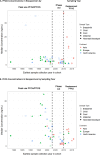Effects of Early-life PFAS Exposure on Child Neurodevelopment: A Review of the Evidence and Research gaps
- PMID: 39888511
- PMCID: PMC11785707
- DOI: 10.1007/s40572-024-00464-5
Effects of Early-life PFAS Exposure on Child Neurodevelopment: A Review of the Evidence and Research gaps
Abstract
Purpose of review: Per- and polyfluoroalkyl substances (PFAS) are persistent chemicals with many modern applications, leading to widespread contamination and universal human exposure. PFAS exposure during early life is of particular concern, given susceptibility of the developing fetal and infant brain to toxic exposures. This review aims to synthesize current evidence, discuss methodological challenges, and highlight research gaps to guide future studies on the impact of PFAS on neurodevelopment.
Recent findings: Sixty-one studies in total were published from 2008 to March 2024, with 35 in the last five years. Findings primarily link early life PFAS exposure to reduced cognitive, motor, and language development in infancy and increased behavioral issues like hyperactivity in childhood. Large studies have shown mixed results concerning child cognition, executive function, autism, and ADHD, with some indicating no association or unexpected protective findings. Sex-specific associations have been observed, but not consistently. Most research has addressed low-level exposure, suggesting subtle but potentially significant population-wide neurodevelopmental effects. Recent research also highlights concerns about newer, alternative PFAS, suggesting they too might affect neurodevelopment. The effects of early-life PFAS exposure on neurodevelopment merit further study, particularly the cumulative effects of prenatal and postnatal exposures. Research has not fully explored sensitive subgroups or potential mitigating factors such as breastfeeding and nutrient intake, which will require larger, more diverse samples. Future directions include deeper study of PFAS mixtures, interactions with other neurotoxic environmental chemicals, and effects of newer PFAS types. There is also a need to focus on neuropsychological functioning in later childhood, using direct assessments for more reliable evaluations.
Keywords: ADHD; Autism; Cognition; Neurobehavior; Neurodevelopment; PFAS; Perfluoroalkyl.
© 2025. The Author(s).
Conflict of interest statement
Declarations. Competing Interests: The authors declare no competing interests.
Figures
Similar articles
-
Association between prenatal or early postnatal exposure to perfluoroalkyl substances and language development in 18 to 36-month-old children from the Odense Child Cohort.Environ Health. 2023 May 30;22(1):46. doi: 10.1186/s12940-023-00993-w. Environ Health. 2023. PMID: 37254153 Free PMC article.
-
Prenatal exposure to per- and polyfluoroalkyl substances (PFAS) and associations with attention-deficit/hyperactivity disorder and autism spectrum disorder in children.Environ Res. 2021 Nov;202:111692. doi: 10.1016/j.envres.2021.111692. Epub 2021 Jul 19. Environ Res. 2021. PMID: 34293314
-
Prenatal exposure to perfluoroalkyl substances and associations with symptoms of attention-deficit/hyperactivity disorder and cognitive functions in preschool children.Int J Hyg Environ Health. 2020 Jan;223(1):80-92. doi: 10.1016/j.ijheh.2019.10.003. Epub 2019 Oct 22. Int J Hyg Environ Health. 2020. PMID: 31653559 Free PMC article.
-
The Minderoo-Monaco Commission on Plastics and Human Health.Ann Glob Health. 2023 Mar 21;89(1):23. doi: 10.5334/aogh.4056. eCollection 2023. Ann Glob Health. 2023. PMID: 36969097 Free PMC article. Review.
-
Early-Life Exposure to Per- and Poly-Fluorinated Alkyl Substances and Growth, Adiposity, and Puberty in Children: A Systematic Review.Front Endocrinol (Lausanne). 2021 Sep 9;12:683297. doi: 10.3389/fendo.2021.683297. eCollection 2021. Front Endocrinol (Lausanne). 2021. PMID: 34566884 Free PMC article.
Cited by
-
Epigenetic Consequences of In Utero PFAS Exposure: Implications for Development and Long-Term Health.Int J Environ Res Public Health. 2025 Jun 10;22(6):917. doi: 10.3390/ijerph22060917. Int J Environ Res Public Health. 2025. PMID: 40566344 Free PMC article. Review.
-
PFAS Exposure, Mental Health, and Environmental Justice in the United States: Impacts on Marginalized Communities.Int J Environ Res Public Health. 2025 Jul 15;22(7):1116. doi: 10.3390/ijerph22071116. Int J Environ Res Public Health. 2025. PMID: 40724183 Free PMC article. Review.
-
Exposure to Per- and Polyfluoroalkyl Substances (PFASs) in Healthcare: Environmental and Clinical Insights.Life (Basel). 2025 Jul 1;15(7):1057. doi: 10.3390/life15071057. Life (Basel). 2025. PMID: 40724559 Free PMC article. Review.
-
Perfluoroalkyl substance pollutants disrupt microglia function and trigger transcriptional and epigenomic changes.Toxicology. 2025 Nov;517:154198. doi: 10.1016/j.tox.2025.154198. Epub 2025 May 24. Toxicology. 2025. PMID: 40419075
-
Childhood infectious diseases: experiences and challenges.World J Pediatr. 2025 Jul 10. doi: 10.1007/s12519-025-00941-3. Online ahead of print. World J Pediatr. 2025. PMID: 40634767 No abstract available.
References
-
- Pan Y, et al. Novel Chlorinated Polyfluorinated Ether Sulfonates and Legacy Per-/Polyfluoroalkyl Substances: Placental Transfer and Relationship with Serum Albumin and Glomerular Filtration Rate, vol. 51. Environmental Science & Technology; 2017. p. 634–44. - PubMed
-
- Mamsen LS, et al. Concentrations of perfluoroalkyl substances (PFASs) in human embryonic and fetal organs from first, second, and third trimester pregnancies. Environ Int. 2019;124:482–92. - PubMed
-
- Cao Y, Ng C. Absorption, distribution, and toxicity of per- and polyfluoroalkyl substances (PFAS) in the brain: a review. Environ Science: Processes Impacts. 2021;23(11):1623–40. - PubMed
Publication types
MeSH terms
Substances
Grants and funding
LinkOut - more resources
Full Text Sources
Medical
Research Materials



